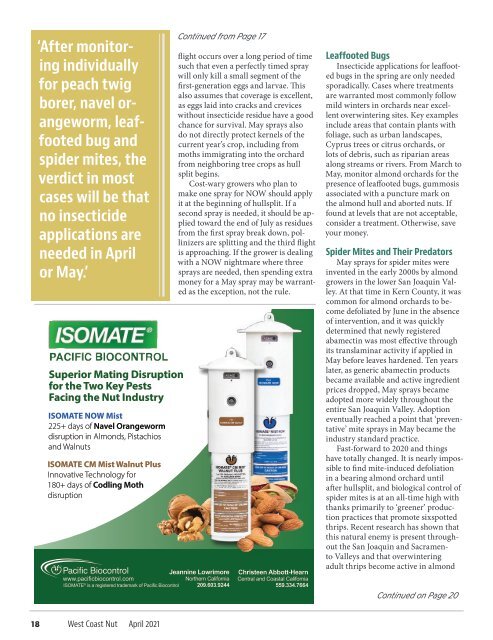You also want an ePaper? Increase the reach of your titles
YUMPU automatically turns print PDFs into web optimized ePapers that Google loves.
‘After monitoring<br />
individually<br />
for peach twig<br />
borer, navel orangeworm,<br />
leaffooted<br />
bug and<br />
spider mites, the<br />
verdict in most<br />
cases will be that<br />
no insecticide<br />
applications are<br />
needed in <strong>April</strong><br />
or May.’<br />
Superior Mating Disruption<br />
for the Two Key Pests<br />
Facing the <strong>Nut</strong> Industry<br />
ISOMATE NOW Mist<br />
225+ days of Navel Orangeworm<br />
disruption in Almonds, Pistachios<br />
and Walnuts<br />
ISOMATE CM Mist Walnut Plus<br />
Innovative Technology for<br />
180+ days of Codling Moth<br />
disruption<br />
®<br />
Continued from Page 17<br />
Jeannine Lowrimore<br />
www.pacificbiocontrol.com<br />
Northern California<br />
ISOMATE ® is a registered trademark of Pacific Biocontrol 209.603.9244<br />
flight occurs over a long period of time<br />
such that even a perfectly timed spray<br />
will only kill a small segment of the<br />
first-generation eggs and larvae. This<br />
also assumes that coverage is excellent,<br />
as eggs laid into cracks and crevices<br />
without insecticide residue have a good<br />
chance for survival. May sprays also<br />
do not directly protect kernels of the<br />
current year’s crop, including from<br />
moths immigrating into the orchard<br />
from neighboring tree crops as hull<br />
split begins.<br />
Cost-wary growers who plan to<br />
make one spray for NOW should apply<br />
it at the beginning of hullsplit. If a<br />
second spray is needed, it should be applied<br />
toward the end of July as residues<br />
from the first spray break down, pollinizers<br />
are splitting and the third flight<br />
is approaching. If the grower is dealing<br />
with a NOW nightmare where three<br />
sprays are needed, then spending extra<br />
money for a May spray may be warranted<br />
as the exception, not the rule.<br />
Christeen Abbott-Hearn<br />
Central and <strong>Coast</strong>al California<br />
559.334.7664<br />
Leaffooted Bugs<br />
Insecticide applications for leaffooted<br />
bugs in the spring are only needed<br />
sporadically. Cases where treatments<br />
are warranted most commonly follow<br />
mild winters in orchards near excellent<br />
overwintering sites. Key examples<br />
include areas that contain plants with<br />
foliage, such as urban landscapes,<br />
Cyprus trees or citrus orchards, or<br />
lots of debris, such as riparian areas<br />
along streams or rivers. From March to<br />
May, monitor almond orchards for the<br />
presence of leaffooted bugs, gummosis<br />
associated with a puncture mark on<br />
the almond hull and aborted nuts. If<br />
found at levels that are not acceptable,<br />
consider a treatment. Otherwise, save<br />
your money.<br />
Spider Mites and Their Predators<br />
May sprays for spider mites were<br />
invented in the early 2000s by almond<br />
growers in the lower San Joaquin Valley.<br />
At that time in Kern County, it was<br />
common for almond orchards to become<br />
defoliated by June in the absence<br />
of intervention, and it was quickly<br />
determined that newly registered<br />
abamectin was most effective through<br />
its translaminar activity if applied in<br />
May before leaves hardened. Ten years<br />
later, as generic abamectin products<br />
became available and active ingredient<br />
prices dropped, May sprays became<br />
adopted more widely throughout the<br />
entire San Joaquin Valley. Adoption<br />
eventually reached a point that ‘preventative’<br />
mite sprays in May became the<br />
industry standard practice.<br />
Fast-forward to 2020 and things<br />
have totally changed. It is nearly impossible<br />
to find mite-induced defoliation<br />
in a bearing almond orchard until<br />
after hullsplit, and biological control of<br />
spider mites is at an all-time high with<br />
thanks primarily to ‘greener’ production<br />
practices that promote sixspotted<br />
thrips. Recent research has shown that<br />
this natural enemy is present throughout<br />
the San Joaquin and Sacramento<br />
Valleys and that overwintering<br />
adult thrips become active in almond<br />
Continued on Page 20<br />
18 <strong>West</strong> <strong>Coast</strong> <strong>Nut</strong> <strong>April</strong> <strong>2021</strong>


















